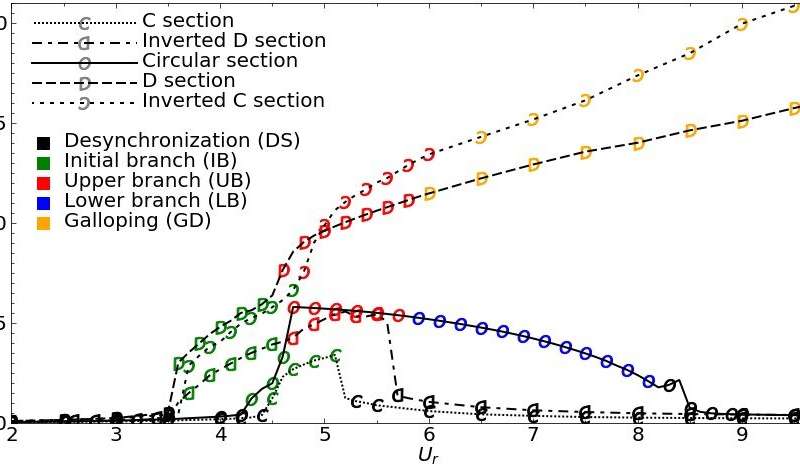Optimizing flow-induced vibrations of an elastically mounted cylinder

Fluid flow across a flexible or elastically mounted structure causes vibrations due to vortex shedding and other similar instabilities, like galloping. The flow-induced vibrations (FIV) are detrimental to structures like skyscrapers, bridges, and chimneys. On the other hand, the fluid-structure interaction (FSI) systems can extract ambient wind or water flow energy from these vibrations, and researchers are exploring ways to modulate them. Therefore, there is a need to mitigate FIV suppression or enhancement of FIV for energy-harvesting applications.
A systematic cross-section variation of a cylinder
While there have been numerous independent cross-section studies on FIV, the effect of systematic variation of front and rear surfaces have not been explored. In this study, we systematically vary the front and rear surface from convex to flat to concave geometry, which are denoted by circular, D, and C-section cylinders. We keep the masses across cylinders constant to rule out the FIV variation due to the inertia effects. The flow across the cylinder generates vortices according to the cylinder cross-section, which exerts an oscillating force back on the cylinder. During vibrations, the apparent flow direction also gets modified and may result in galloping instability vibrations. We employ an immersed boundary method-based computational fluid dynamics solver to compute the flow field and response of the cylinder.
Effects of the shape of the front and the rear surface of the cylinder
The FIV response of the cross-section shows an evident influence of front and rear geometry on the strength of FIV. As the cylinder's rear side is transformed from convex to flat to the concave surface, the synchronized vibrations or lock-in keep reducing. There is no synchronization present for the C-section cylinder. On the contrary, if the cylinder's front side is swept from convex to flat to the concave surface, sustained vibrations with larger amplitude are obtained in a wide range of structural stiffness variations. Therefore, we can directly optimize the cylinder cross-section by reducing the afterbody for vortex suppression and the frontbody for energy harvesting applications.
Modification of vortex shedding frequency for moving bodies
Conventionally, the vortex shedding frequency is assumed to remain constant (corresponding to a stationary cylinder) or match structural vibration frequency, also known as the lock-in condition. However, there is a significant increase in the vortex shedding frequency for moving cylinders, specifically during galloping vibrations. Therefore, the modified vortex shedding frequency needs to be considered for the efficient design of FIV systems.
Overall, the present research, published in the Journal of Fluids and Structures, provides fundamental insights into designing and optimizing vibration suppression and energy harvesting applications in FSI systems.
This story is part of Science X Dialog, where researchers can report findings from their published research articles. Visit this page for information about ScienceX Dialog and how to participate.
More information:
Gaurav Sharma et al, Flow-induced vibrations of elastically-mounted C- and D-section cylinders, Journal of Fluids and Structures (2022). DOI: 10.1016/j.jfluidstructs.2022.103501
Gaurav Sharma is a Ph.D. student at Mechanical Engineering Department, I.I.T. Bombay, Mumbai, India. Hemanshul Garg has earned his Ph.D. from I.I.T. Bombay in 2019 and Rajneesh Bhardwaj is a Professor in the same department.
Lab website: sites.google.com/view/interfaces-fsi-lab